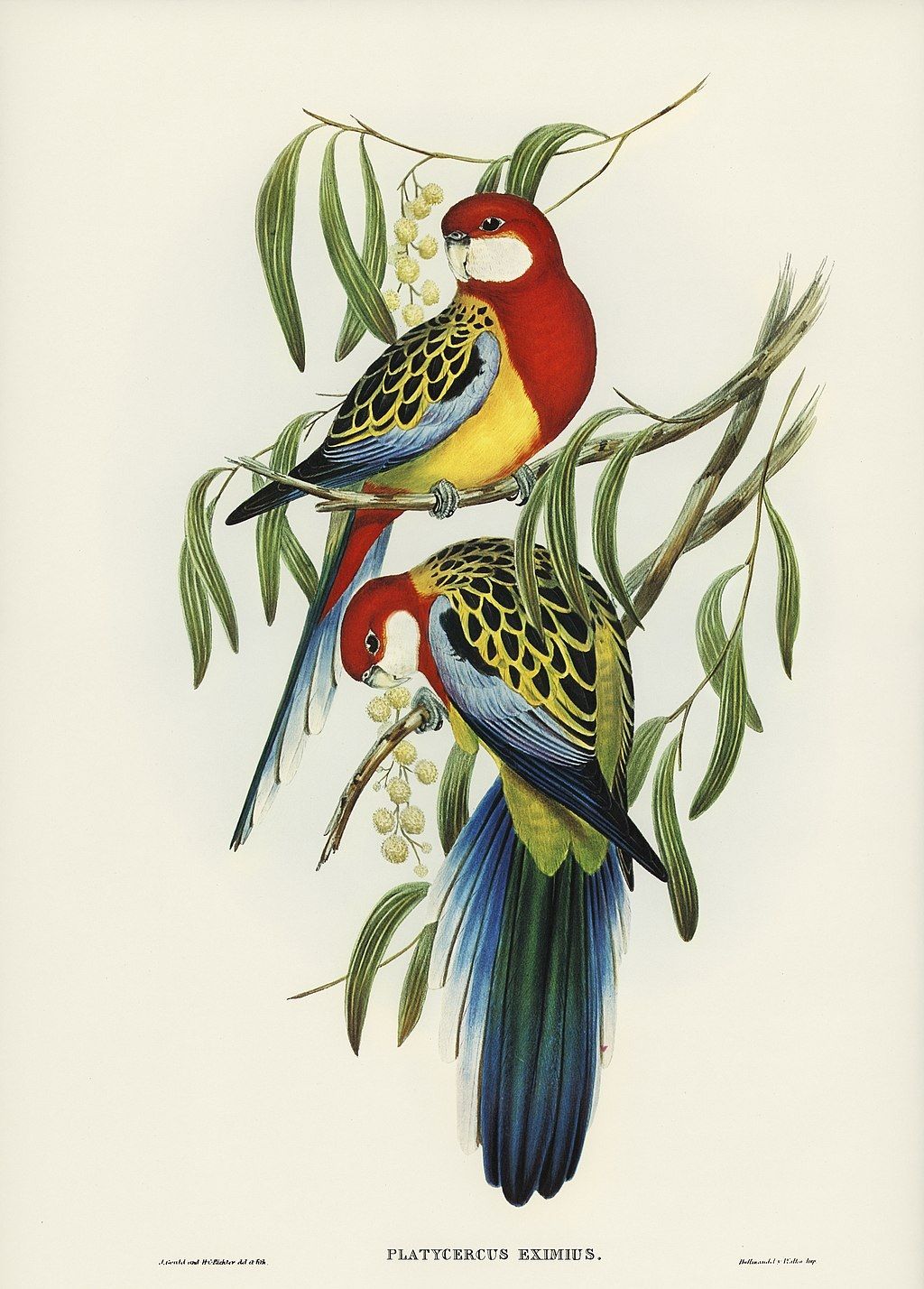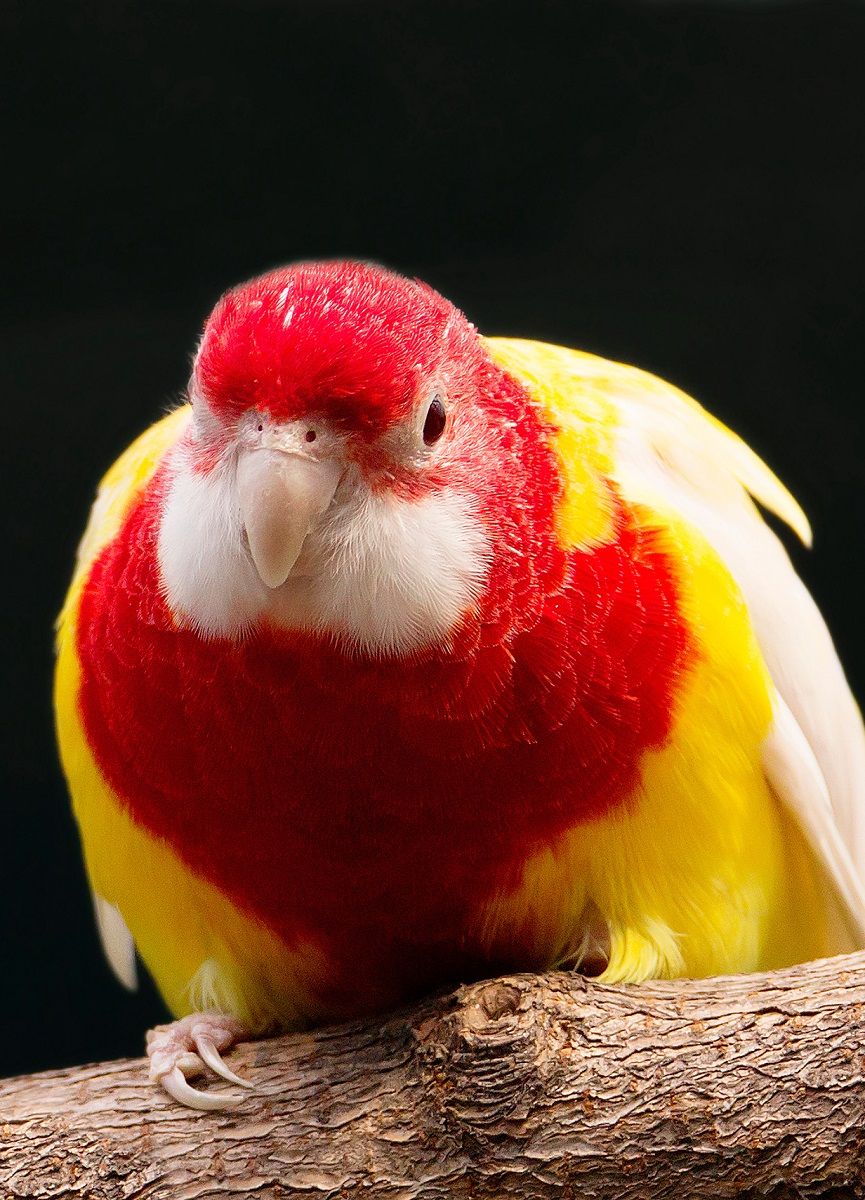Parrots in general are known for being extremely colorful birds, but this one takes the cake! The eastern rosella (Platycercus eximius) from Australia is not a large bird, but it sure isn’t easy to overlook. It’s also a popular pet thanks to its fun and friendly personality.
Keep reading for everything you need to know about the eastern rosella parrot, including where they’re from, what they eat, and how to care for one in your home!
| Name(s) (common, scientific) | Eastern rosella, Platycercus eximius |
| Natural habitat | Lightly wooded areas in (South)Eastern Australia |
| Adult size | 30 cm/12″ long, 100 grams |
| Lifespan | 20-30 years |
| Noise level | Low (for a parrot) |
This post contains affiliate links. If you make a purchase, a small percentage will go directly to Psittacology at no additional cost to you. Thank you for supporting Psittacology!
Eastern rosella appearance
Despite not being very large, the eastern rosella is a real looker. This parrot sports a bright red head and chest, white cheeks, yellow-green belly and “pants”, scalloped yellow-green and black top wing feathers, green back, blue wing undersides, and a long blue-green tail.
There are three different subspecies, each of which occurs in a different area and has unique characteristics:
- Platycercus eximius eximius: green-rimmed top wing feathers
- Platycercus eximius elecica: called the golden-mantled rosella because the top wing feathers are yellow-rimmed
- Platycercus eximius diemenensis: larger white cheek patches
Young eastern rosellas look slightly different from the adults until their first molt at 2-6 months of age. Their colors aren’t quite as bright, and their beaks start off yellow rather than white.
Lastly, as if things weren’t complicated enough, there are also selectively bred eastern rosella color morphs for sale in the pet trade. Rubinos are particularly common. You can recognize them by their red-yellow-white coloration, without any blue, green, or black.

Hybrids
If you went birdwatching and spotted an unusual rosella, rest assured: you’re not going crazy. Different members of the genus Platycercus can reproduce together, leading to hybrid birds popping up in some areas.
Eastern rosella × crimson rosella (P. elegans) is not uncommon, nor is eastern rosella × pale-headed rosella (P. adscitus). The resulting birds can be quite striking!
Is my eastern rosella male or female?
Eastern rosellas can be sexed visually by looking at their coloration. That being said, as with many other species, you’ll have trouble figuring it out until the bird is fully grown and has gone through its first molt.
- Female Eastern rosellas are colorful, but their colors aren’t as bright as those of the males.
- Most females have a white stripe on the underside of their wings. You’ll have to carefully hold the bird and extend the wing to look for it. Juveniles also have this, so this visual is only going to help you with mature birds.
- The male’s head and beak are bulkier than that of the female and his cheek patches tend to be larger.

Eastern rosella range & natural habitat
Range
The eastern rosella is pretty appropriately named. It is indeed naturally found exclusively in Eastern and Southeastern Australia, including the island of Tasmania.
Although it’s not native to New Zealand, the eastern rosella is an introduced species there. There are multiple populations, likely as a result of accidental escapees (for example, 12 rosellas escaped in Dunedin when their cage was destroyed) as well as birds released on purpose (for example, a shipment was released after entry was refused by the NZ Customs Department in 1910).
Natural habitat
Eastern rosellas thrive in lightly wooded habitats: open forest and forest edges, patches of Eucalyptus trees, parks, farmland, and similar. They’re found up to moderate altitudes (1,250m or 4,100ft) and prefer zones that get plenty of rainfall or have their own water sources.
Wild eastern rosellas can usually be found in pairs or small groups, sometimes with other parrot and rosella species. Like most parrots, they nest in hollow trees.
Threat level
The IUCN Red List considers the eastern rosella to be a species of Least Concern. It notes that it has a wide natural range and the population appears to be on the increase.
The reason this species is doing so well is, ironically, likely due to habitat degradation. Nature is being replaced by agriculture, which is problematic for many species but perfect for a bird like this one, as it gets access to plenty of tasty crops like maize and grain.

Eastern rosella diet
In the wild
Like many other parrots, eastern rosellas’ favorite food is seeds, particularly thistle seeds, although they’re also very fond of fruits like apples. Researchers have found they also eat a variety of berries, flowers, flower buds, and even insects.
For as long as humans have been present in eastern Australia, they’ve waged war on the eastern rosella (and its other rosella cousins). The species has long been considered a pest, as it’s known for raiding orchards and causing damage to harvests.
Although they’re protected by law, farmers are still granted permits to kill rosellas if they can prove damage to their crops and a lack of other possible solutions.
In captivity
Given their varied diet in the wild, it’s not surprising that rosellas can’t thrive on a simple diet of mixed seeds in captivity (nor can any parrot, for that matter!). Veterinarians, including Psittacology’s resident vet Dr. Daisy May, agree nowadays that a base diet of high-quality pellets works best.
Aside from its daily pellet rations, you should be offering your eastern rosella all sorts of fresh produce. Vegetables can be given daily (leafy greens, carrot, bell pepper, etc.) and fruits a few times a week (apple, banana, orange, etc.).
You can further enrich your rosella’s diet with (sprouted) seeds, cooked grains (like whole-wheat pasta and rice), treats (millet, nuts), and the occasional protein-based snack like boiled egg or freeze-dried mealworms. You can also forage for parrot-safe branches, weeds, and flowers.
For much more info about what to feed your bird and why, you can head over to the post on parrot diet.

Eastern rosella as a pet
Eastern rosellas are one of the more common parrot species to be kept as pets. They’re mainly popular as aviary birds—for their pretty colors, mostly, because their territorial personalities don’t actually make them a great choice for mixing with other aviary birds like budgies.
Because a well-socialized rosella is generally fun, active, curious, social, and not too loud, this species can make a great choice if you’re looking for an indoor pet. They’re known for being more independent than other parrots, but most still really like spending time with their humans.
Housing
As with all parrots, the bigger the cage the better. Go for a minimum cage length of 1m (40″) to make sure your eastern rosella can stretch its wings. For safety reasons, the cage bars should be no more than 1.25cm (0.5″ apart).
The cage should contain plenty of parrot toys to help keep your bird entertained. It should also have a variety of natural perches, as well as a food bowl and one or more sources of fresh water.
Enrichment
Because parrots are so intelligent, they get bored easily, which can result in stress and unwanted behaviors like feather plucking. Luckily, there are plenty of things you can do to keep your eastern rosella entertained.
I’ve already mentioned toys, but you can also consider:
- Spending plenty of time together: hanging out, playing, training, and more. Place your rosella’s cage in a high-traffic zone of the house (like the living room).
- Out-of-cage time: even if you’re not playing with it, your rosella should have the opportunity to explore at least a few hours a day. You can place a play gym on top of its cage to give it a place to hang out.
- Companionship: unless you work from home, it’s probably best to keep two birds. They’re extremely social and get lonely quickly.
- Foraging: including foraging toys in your bird’s cage and/or giving it a foraging box is a great way to keep it busy for ages.
Noise level & talking
As I’ve briefly mentioned, eastern rosellas aren’t known for being particularly loud as far as parrots go. Although all parrots make noise, rosellas mostly stick to whistles and cheeps rather than loud flock calls. They should be suitable for most apartments, unless your walls are very thin.
Want to have a listen? You can do so over at Xeno-Canto: Platycercus eximius.
As for talking, yes, they can learn! Eastern rosellas aren’t among the most talented talking parrots, but don’t be surprised if yours starts imitating household noises. With patience and lots of training, it may even pick up some words or tunes.
Safety & emergencies
Because parrots are endlessly curious and rather fragile, they can easily get themselves in trouble.
Any space your rosella has access to should be parrot-proofed, and you should be aware of basic parrot emergency care.
If you have any more questions about the eastern rosella or if you want to share your own experiences with this colorful parrot, don’t hesitate to leave a comment below!
Sources & further reading
- Bridgewater, A. E. (1934). The food of Platycercus eximius and P. elegans. Emu-Austral Ornithology, 33(3), 175-186.
- Parr, M., & Juniper, T. (2010). Parrots: a guide to parrots of the world. Bloomsbury Publishing.
- Shipham, A., Joseph, L., Schmidt, D. J., Drew, A., Mason, I., & Hughes, J. M. (2019). Dissection by genomic and plumage variation of a geographically complex hybrid zone between two Australian non-sister parrot species, Platycercus adscitus and Platycercus eximius. Heredity, 122(4), 402-416.
- Wright, D., & Clout, M. N. (2001). The eastern rosella (Platycercus eximius) in New Zealand (pp. 5-27). Department of Conservation.
- Wyndham, E., Le Gay Brereton, J., & Beeton, R. J. (1983). Moult and plumages of eastern rosellas Platycercus eximius. Emu-Austral Ornithology, 83(4), 242-246.
